LSBU: International Strategic Management & Innovation at BAT
VerifiedAdded on 2023/07/13
|26
|6733
|198
Report
AI Summary
This report provides a comprehensive analysis of British American Tobacco's (BAT) strategic management and innovation within the international tobacco market. It begins by outlining BAT's current strategic positioning, followed by a detailed PESTEL analysis, examining the political, economic, social, technological, environmental, and legal factors impacting the company. The report then delves into the external micro-environment using Porter's Five Forces model, assessing the bargaining power of suppliers and buyers, the threat of new entrants and substitutes, and the rivalry among existing firms. An internal analysis, including Porter's Value Chain and SWOT analysis, identifies BAT's strengths and weaknesses. The report further explores BAT's innovation strategy, strategic situation, and potential future expansion, culminating in recommendations for growth and development, a strategy selection, and a CANVAS business model for strategy implementation. The report uses secondary data to compile a report on the company’s operations. Multiple-source secondary data is used to get an objective perspective of the company.

1
London south Bank University
International Strategic Management and Innovation
MMP_7_ISM_22/23
MSc. International Business Management with Internship (JAN)
Report Title: British American Tobacco
Submitted by
Aminul Islam
Id: 4036813
Submitted to
Dr Yehia Nawar
Date: 19/12/2022
Contents
London south Bank University
International Strategic Management and Innovation
MMP_7_ISM_22/23
MSc. International Business Management with Internship (JAN)
Report Title: British American Tobacco
Submitted by
Aminul Islam
Id: 4036813
Submitted to
Dr Yehia Nawar
Date: 19/12/2022
Contents
Paraphrase This Document
Need a fresh take? Get an instant paraphrase of this document with our AI Paraphraser

2
British American Tobacco................................................................................................3
Introduction........................................................................................................................3
Findings..............................................................................................................................4
BAT’s Current Strategic Positioning...............................................................................4
PESTEL Analysis........................................................................................................5
The External Micro Environment....................................................................................7
Porter’s Five Forces Model.........................................................................................8
Internal Analysis............................................................................................................10
Porter’s Value Chain Analysis...................................................................................10
Strengths and Weaknesses Analysis..............................................................................14
SWOT Analysis.........................................................................................................14
Innovation Strategy........................................................................................................15
BAT’s Strategic Situation..............................................................................................16
Cost Leadership.........................................................................................................17
Differentiation............................................................................................................17
Focus Strategy...........................................................................................................17
Future Expansion.......................................................................................................17
Recommendations for Growth and Development.............................................................18
Strategy Selection..........................................................................................................20
CANVAS Business Model for Strategy Implementation..............................................21
British American Tobacco................................................................................................3
Introduction........................................................................................................................3
Findings..............................................................................................................................4
BAT’s Current Strategic Positioning...............................................................................4
PESTEL Analysis........................................................................................................5
The External Micro Environment....................................................................................7
Porter’s Five Forces Model.........................................................................................8
Internal Analysis............................................................................................................10
Porter’s Value Chain Analysis...................................................................................10
Strengths and Weaknesses Analysis..............................................................................14
SWOT Analysis.........................................................................................................14
Innovation Strategy........................................................................................................15
BAT’s Strategic Situation..............................................................................................16
Cost Leadership.........................................................................................................17
Differentiation............................................................................................................17
Focus Strategy...........................................................................................................17
Future Expansion.......................................................................................................17
Recommendations for Growth and Development.............................................................18
Strategy Selection..........................................................................................................20
CANVAS Business Model for Strategy Implementation..............................................21
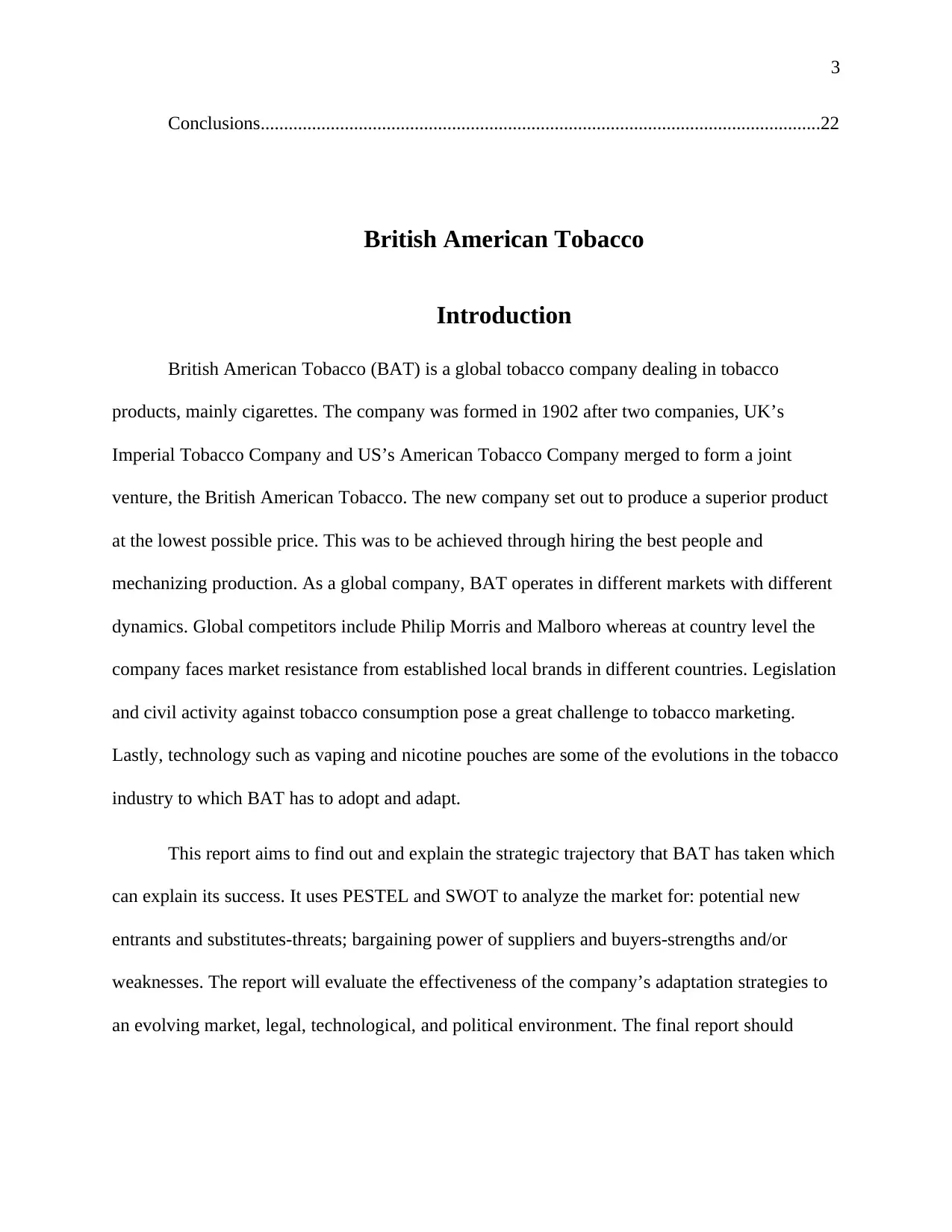
3
Conclusions........................................................................................................................22
British American Tobacco
Introduction
British American Tobacco (BAT) is a global tobacco company dealing in tobacco
products, mainly cigarettes. The company was formed in 1902 after two companies, UK’s
Imperial Tobacco Company and US’s American Tobacco Company merged to form a joint
venture, the British American Tobacco. The new company set out to produce a superior product
at the lowest possible price. This was to be achieved through hiring the best people and
mechanizing production. As a global company, BAT operates in different markets with different
dynamics. Global competitors include Philip Morris and Malboro whereas at country level the
company faces market resistance from established local brands in different countries. Legislation
and civil activity against tobacco consumption pose a great challenge to tobacco marketing.
Lastly, technology such as vaping and nicotine pouches are some of the evolutions in the tobacco
industry to which BAT has to adopt and adapt.
This report aims to find out and explain the strategic trajectory that BAT has taken which
can explain its success. It uses PESTEL and SWOT to analyze the market for: potential new
entrants and substitutes-threats; bargaining power of suppliers and buyers-strengths and/or
weaknesses. The report will evaluate the effectiveness of the company’s adaptation strategies to
an evolving market, legal, technological, and political environment. The final report should
Conclusions........................................................................................................................22
British American Tobacco
Introduction
British American Tobacco (BAT) is a global tobacco company dealing in tobacco
products, mainly cigarettes. The company was formed in 1902 after two companies, UK’s
Imperial Tobacco Company and US’s American Tobacco Company merged to form a joint
venture, the British American Tobacco. The new company set out to produce a superior product
at the lowest possible price. This was to be achieved through hiring the best people and
mechanizing production. As a global company, BAT operates in different markets with different
dynamics. Global competitors include Philip Morris and Malboro whereas at country level the
company faces market resistance from established local brands in different countries. Legislation
and civil activity against tobacco consumption pose a great challenge to tobacco marketing.
Lastly, technology such as vaping and nicotine pouches are some of the evolutions in the tobacco
industry to which BAT has to adopt and adapt.
This report aims to find out and explain the strategic trajectory that BAT has taken which
can explain its success. It uses PESTEL and SWOT to analyze the market for: potential new
entrants and substitutes-threats; bargaining power of suppliers and buyers-strengths and/or
weaknesses. The report will evaluate the effectiveness of the company’s adaptation strategies to
an evolving market, legal, technological, and political environment. The final report should
⊘ This is a preview!⊘
Do you want full access?
Subscribe today to unlock all pages.

Trusted by 1+ million students worldwide

4
enable the reader understand what BAT does, why it does it, and how it does it to achieve
success.
The study will use secondary data to compile a report on the company’s operations.
Multiple-source secondary data will be used to get an objective perspective of the company.
From the company’s website, first-hand information is available from its own reports. Consumer
index reports will be used to analyze tobacco consumption trends. Other longitudinal reports
about tobacco industry will be helpful in understanding evolution in tobacco industry and what it
means for its future.
Findings
BAT’s Current Strategic Positioning
BAT operates in the international tobacco market. The tobacco market is dynamic in
terms of changing legislation and campaigns which seek to curb tobacco trade (National Center
for Biotechnology Information, 2012), new scientific discoveries which associate tobacco
consumption with multiple health risks, new innovations seeking to replace tobacco
consumption; and climate change affecting tobacco farming (WHO, 2022). BAT has to contend
with these challenges for it to continue with tobacco business as a going concern. The internal
coping mechanisms adopted by BAT should be effective enough to enable the business to thrive
in a hostile environment. Put differently, BAT should strategically align its operations with the
external environment for optimal performance. To achieve such optimality, the company should
first assess the external environment within which it operates or seeks to operate. To perform an
external environment assessment, we use PESTEL analysis tool.
enable the reader understand what BAT does, why it does it, and how it does it to achieve
success.
The study will use secondary data to compile a report on the company’s operations.
Multiple-source secondary data will be used to get an objective perspective of the company.
From the company’s website, first-hand information is available from its own reports. Consumer
index reports will be used to analyze tobacco consumption trends. Other longitudinal reports
about tobacco industry will be helpful in understanding evolution in tobacco industry and what it
means for its future.
Findings
BAT’s Current Strategic Positioning
BAT operates in the international tobacco market. The tobacco market is dynamic in
terms of changing legislation and campaigns which seek to curb tobacco trade (National Center
for Biotechnology Information, 2012), new scientific discoveries which associate tobacco
consumption with multiple health risks, new innovations seeking to replace tobacco
consumption; and climate change affecting tobacco farming (WHO, 2022). BAT has to contend
with these challenges for it to continue with tobacco business as a going concern. The internal
coping mechanisms adopted by BAT should be effective enough to enable the business to thrive
in a hostile environment. Put differently, BAT should strategically align its operations with the
external environment for optimal performance. To achieve such optimality, the company should
first assess the external environment within which it operates or seeks to operate. To perform an
external environment assessment, we use PESTEL analysis tool.
Paraphrase This Document
Need a fresh take? Get an instant paraphrase of this document with our AI Paraphraser
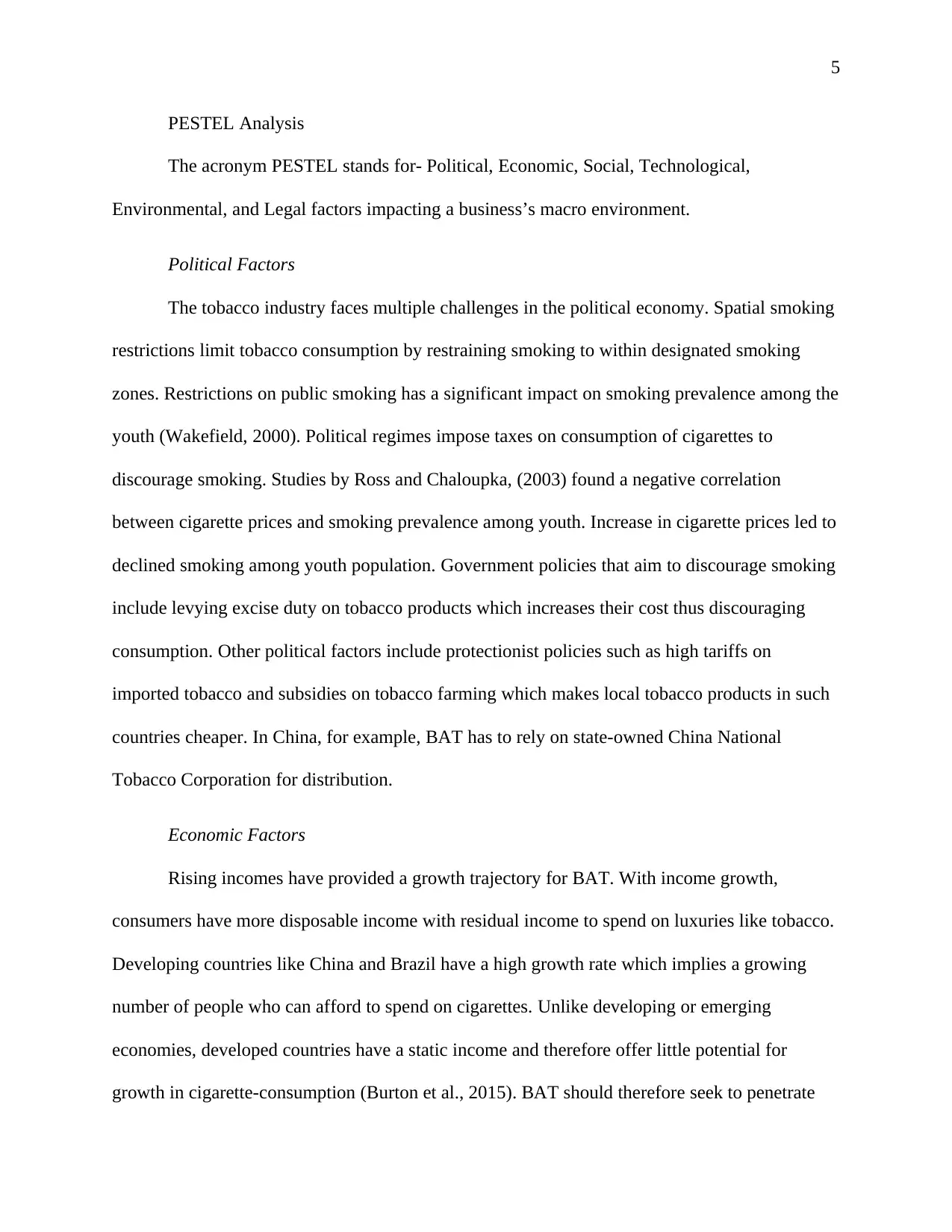
5
PESTEL Analysis
The acronym PESTEL stands for- Political, Economic, Social, Technological,
Environmental, and Legal factors impacting a business’s macro environment.
Political Factors
The tobacco industry faces multiple challenges in the political economy. Spatial smoking
restrictions limit tobacco consumption by restraining smoking to within designated smoking
zones. Restrictions on public smoking has a significant impact on smoking prevalence among the
youth (Wakefield, 2000). Political regimes impose taxes on consumption of cigarettes to
discourage smoking. Studies by Ross and Chaloupka, (2003) found a negative correlation
between cigarette prices and smoking prevalence among youth. Increase in cigarette prices led to
declined smoking among youth population. Government policies that aim to discourage smoking
include levying excise duty on tobacco products which increases their cost thus discouraging
consumption. Other political factors include protectionist policies such as high tariffs on
imported tobacco and subsidies on tobacco farming which makes local tobacco products in such
countries cheaper. In China, for example, BAT has to rely on state-owned China National
Tobacco Corporation for distribution.
Economic Factors
Rising incomes have provided a growth trajectory for BAT. With income growth,
consumers have more disposable income with residual income to spend on luxuries like tobacco.
Developing countries like China and Brazil have a high growth rate which implies a growing
number of people who can afford to spend on cigarettes. Unlike developing or emerging
economies, developed countries have a static income and therefore offer little potential for
growth in cigarette-consumption (Burton et al., 2015). BAT should therefore seek to penetrate
PESTEL Analysis
The acronym PESTEL stands for- Political, Economic, Social, Technological,
Environmental, and Legal factors impacting a business’s macro environment.
Political Factors
The tobacco industry faces multiple challenges in the political economy. Spatial smoking
restrictions limit tobacco consumption by restraining smoking to within designated smoking
zones. Restrictions on public smoking has a significant impact on smoking prevalence among the
youth (Wakefield, 2000). Political regimes impose taxes on consumption of cigarettes to
discourage smoking. Studies by Ross and Chaloupka, (2003) found a negative correlation
between cigarette prices and smoking prevalence among youth. Increase in cigarette prices led to
declined smoking among youth population. Government policies that aim to discourage smoking
include levying excise duty on tobacco products which increases their cost thus discouraging
consumption. Other political factors include protectionist policies such as high tariffs on
imported tobacco and subsidies on tobacco farming which makes local tobacco products in such
countries cheaper. In China, for example, BAT has to rely on state-owned China National
Tobacco Corporation for distribution.
Economic Factors
Rising incomes have provided a growth trajectory for BAT. With income growth,
consumers have more disposable income with residual income to spend on luxuries like tobacco.
Developing countries like China and Brazil have a high growth rate which implies a growing
number of people who can afford to spend on cigarettes. Unlike developing or emerging
economies, developed countries have a static income and therefore offer little potential for
growth in cigarette-consumption (Burton et al., 2015). BAT should therefore seek to penetrate
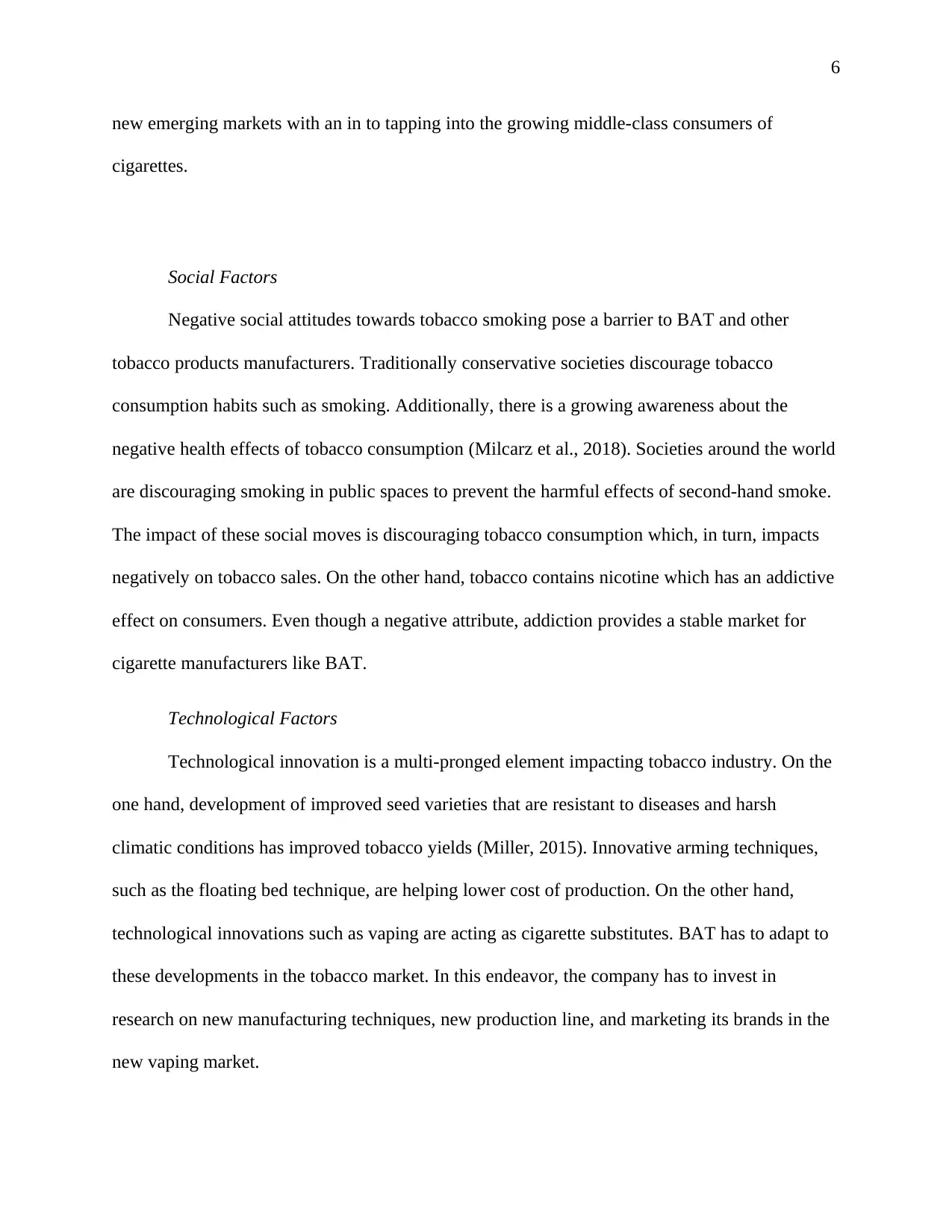
6
new emerging markets with an in to tapping into the growing middle-class consumers of
cigarettes.
Social Factors
Negative social attitudes towards tobacco smoking pose a barrier to BAT and other
tobacco products manufacturers. Traditionally conservative societies discourage tobacco
consumption habits such as smoking. Additionally, there is a growing awareness about the
negative health effects of tobacco consumption (Milcarz et al., 2018). Societies around the world
are discouraging smoking in public spaces to prevent the harmful effects of second-hand smoke.
The impact of these social moves is discouraging tobacco consumption which, in turn, impacts
negatively on tobacco sales. On the other hand, tobacco contains nicotine which has an addictive
effect on consumers. Even though a negative attribute, addiction provides a stable market for
cigarette manufacturers like BAT.
Technological Factors
Technological innovation is a multi-pronged element impacting tobacco industry. On the
one hand, development of improved seed varieties that are resistant to diseases and harsh
climatic conditions has improved tobacco yields (Miller, 2015). Innovative arming techniques,
such as the floating bed technique, are helping lower cost of production. On the other hand,
technological innovations such as vaping are acting as cigarette substitutes. BAT has to adapt to
these developments in the tobacco market. In this endeavor, the company has to invest in
research on new manufacturing techniques, new production line, and marketing its brands in the
new vaping market.
new emerging markets with an in to tapping into the growing middle-class consumers of
cigarettes.
Social Factors
Negative social attitudes towards tobacco smoking pose a barrier to BAT and other
tobacco products manufacturers. Traditionally conservative societies discourage tobacco
consumption habits such as smoking. Additionally, there is a growing awareness about the
negative health effects of tobacco consumption (Milcarz et al., 2018). Societies around the world
are discouraging smoking in public spaces to prevent the harmful effects of second-hand smoke.
The impact of these social moves is discouraging tobacco consumption which, in turn, impacts
negatively on tobacco sales. On the other hand, tobacco contains nicotine which has an addictive
effect on consumers. Even though a negative attribute, addiction provides a stable market for
cigarette manufacturers like BAT.
Technological Factors
Technological innovation is a multi-pronged element impacting tobacco industry. On the
one hand, development of improved seed varieties that are resistant to diseases and harsh
climatic conditions has improved tobacco yields (Miller, 2015). Innovative arming techniques,
such as the floating bed technique, are helping lower cost of production. On the other hand,
technological innovations such as vaping are acting as cigarette substitutes. BAT has to adapt to
these developments in the tobacco market. In this endeavor, the company has to invest in
research on new manufacturing techniques, new production line, and marketing its brands in the
new vaping market.
⊘ This is a preview!⊘
Do you want full access?
Subscribe today to unlock all pages.

Trusted by 1+ million students worldwide
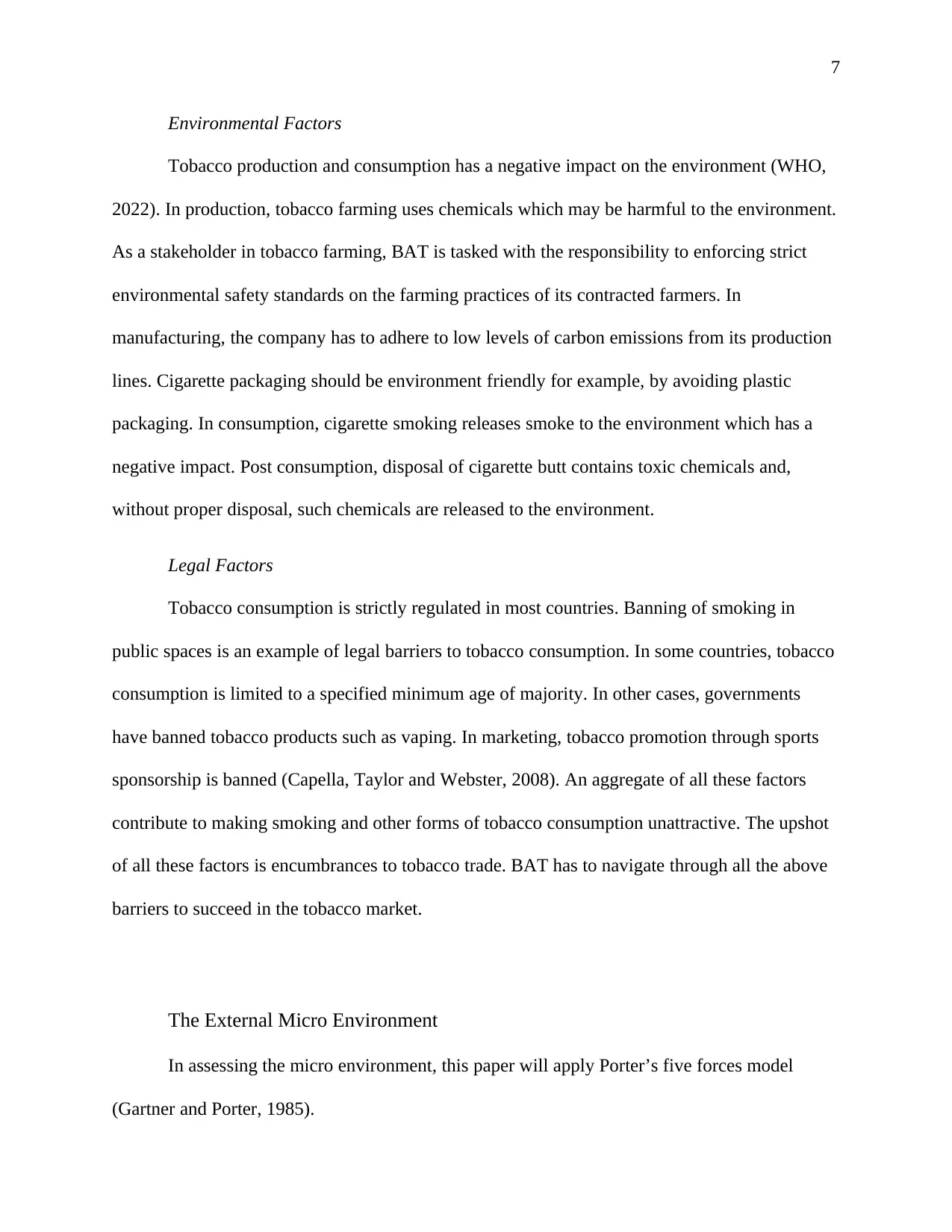
7
Environmental Factors
Tobacco production and consumption has a negative impact on the environment (WHO,
2022). In production, tobacco farming uses chemicals which may be harmful to the environment.
As a stakeholder in tobacco farming, BAT is tasked with the responsibility to enforcing strict
environmental safety standards on the farming practices of its contracted farmers. In
manufacturing, the company has to adhere to low levels of carbon emissions from its production
lines. Cigarette packaging should be environment friendly for example, by avoiding plastic
packaging. In consumption, cigarette smoking releases smoke to the environment which has a
negative impact. Post consumption, disposal of cigarette butt contains toxic chemicals and,
without proper disposal, such chemicals are released to the environment.
Legal Factors
Tobacco consumption is strictly regulated in most countries. Banning of smoking in
public spaces is an example of legal barriers to tobacco consumption. In some countries, tobacco
consumption is limited to a specified minimum age of majority. In other cases, governments
have banned tobacco products such as vaping. In marketing, tobacco promotion through sports
sponsorship is banned (Capella, Taylor and Webster, 2008). An aggregate of all these factors
contribute to making smoking and other forms of tobacco consumption unattractive. The upshot
of all these factors is encumbrances to tobacco trade. BAT has to navigate through all the above
barriers to succeed in the tobacco market.
The External Micro Environment
In assessing the micro environment, this paper will apply Porter’s five forces model
(Gartner and Porter, 1985).
Environmental Factors
Tobacco production and consumption has a negative impact on the environment (WHO,
2022). In production, tobacco farming uses chemicals which may be harmful to the environment.
As a stakeholder in tobacco farming, BAT is tasked with the responsibility to enforcing strict
environmental safety standards on the farming practices of its contracted farmers. In
manufacturing, the company has to adhere to low levels of carbon emissions from its production
lines. Cigarette packaging should be environment friendly for example, by avoiding plastic
packaging. In consumption, cigarette smoking releases smoke to the environment which has a
negative impact. Post consumption, disposal of cigarette butt contains toxic chemicals and,
without proper disposal, such chemicals are released to the environment.
Legal Factors
Tobacco consumption is strictly regulated in most countries. Banning of smoking in
public spaces is an example of legal barriers to tobacco consumption. In some countries, tobacco
consumption is limited to a specified minimum age of majority. In other cases, governments
have banned tobacco products such as vaping. In marketing, tobacco promotion through sports
sponsorship is banned (Capella, Taylor and Webster, 2008). An aggregate of all these factors
contribute to making smoking and other forms of tobacco consumption unattractive. The upshot
of all these factors is encumbrances to tobacco trade. BAT has to navigate through all the above
barriers to succeed in the tobacco market.
The External Micro Environment
In assessing the micro environment, this paper will apply Porter’s five forces model
(Gartner and Porter, 1985).
Paraphrase This Document
Need a fresh take? Get an instant paraphrase of this document with our AI Paraphraser
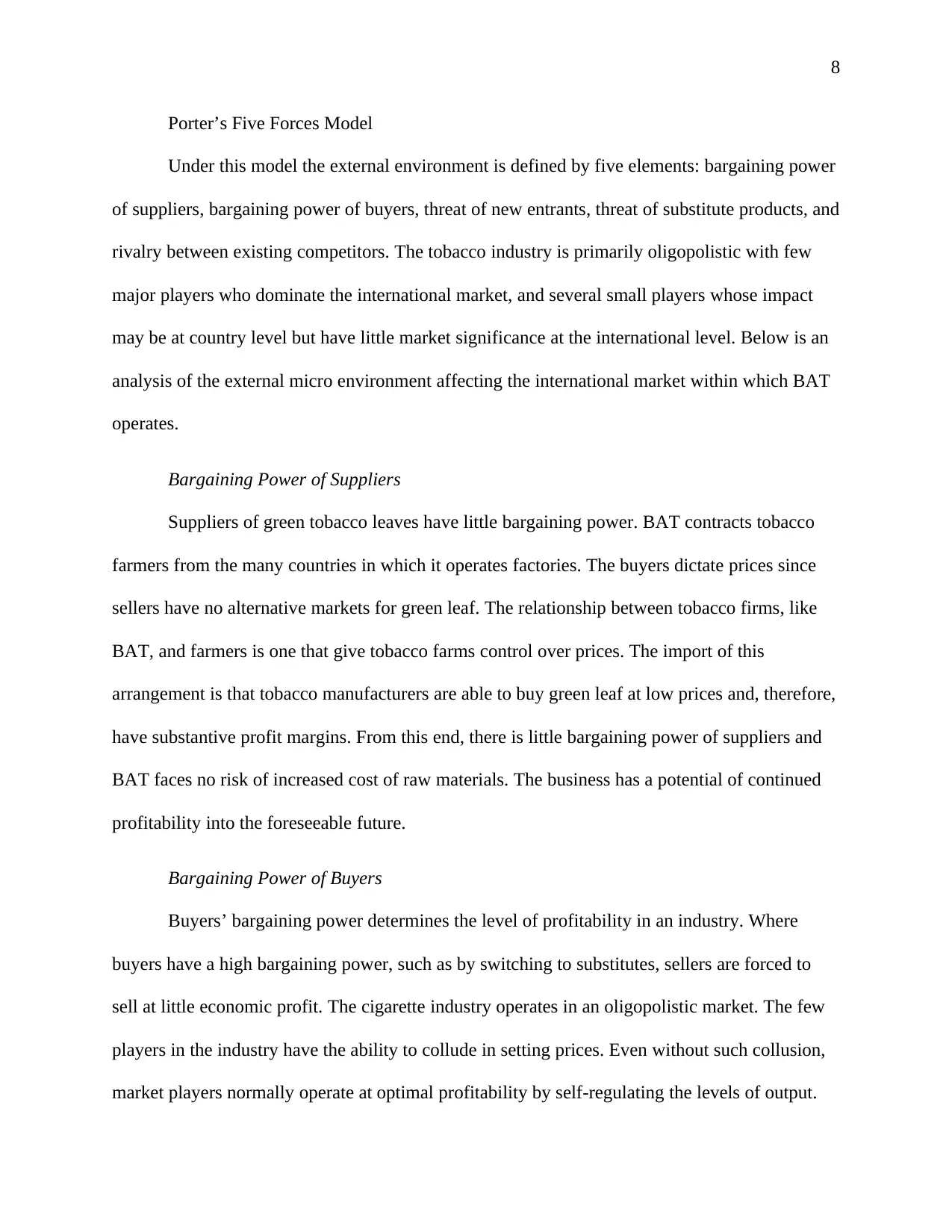
8
Porter’s Five Forces Model
Under this model the external environment is defined by five elements: bargaining power
of suppliers, bargaining power of buyers, threat of new entrants, threat of substitute products, and
rivalry between existing competitors. The tobacco industry is primarily oligopolistic with few
major players who dominate the international market, and several small players whose impact
may be at country level but have little market significance at the international level. Below is an
analysis of the external micro environment affecting the international market within which BAT
operates.
Bargaining Power of Suppliers
Suppliers of green tobacco leaves have little bargaining power. BAT contracts tobacco
farmers from the many countries in which it operates factories. The buyers dictate prices since
sellers have no alternative markets for green leaf. The relationship between tobacco firms, like
BAT, and farmers is one that give tobacco farms control over prices. The import of this
arrangement is that tobacco manufacturers are able to buy green leaf at low prices and, therefore,
have substantive profit margins. From this end, there is little bargaining power of suppliers and
BAT faces no risk of increased cost of raw materials. The business has a potential of continued
profitability into the foreseeable future.
Bargaining Power of Buyers
Buyers’ bargaining power determines the level of profitability in an industry. Where
buyers have a high bargaining power, such as by switching to substitutes, sellers are forced to
sell at little economic profit. The cigarette industry operates in an oligopolistic market. The few
players in the industry have the ability to collude in setting prices. Even without such collusion,
market players normally operate at optimal profitability by self-regulating the levels of output.
Porter’s Five Forces Model
Under this model the external environment is defined by five elements: bargaining power
of suppliers, bargaining power of buyers, threat of new entrants, threat of substitute products, and
rivalry between existing competitors. The tobacco industry is primarily oligopolistic with few
major players who dominate the international market, and several small players whose impact
may be at country level but have little market significance at the international level. Below is an
analysis of the external micro environment affecting the international market within which BAT
operates.
Bargaining Power of Suppliers
Suppliers of green tobacco leaves have little bargaining power. BAT contracts tobacco
farmers from the many countries in which it operates factories. The buyers dictate prices since
sellers have no alternative markets for green leaf. The relationship between tobacco firms, like
BAT, and farmers is one that give tobacco farms control over prices. The import of this
arrangement is that tobacco manufacturers are able to buy green leaf at low prices and, therefore,
have substantive profit margins. From this end, there is little bargaining power of suppliers and
BAT faces no risk of increased cost of raw materials. The business has a potential of continued
profitability into the foreseeable future.
Bargaining Power of Buyers
Buyers’ bargaining power determines the level of profitability in an industry. Where
buyers have a high bargaining power, such as by switching to substitutes, sellers are forced to
sell at little economic profit. The cigarette industry operates in an oligopolistic market. The few
players in the industry have the ability to collude in setting prices. Even without such collusion,
market players normally operate at optimal profitability by self-regulating the levels of output.
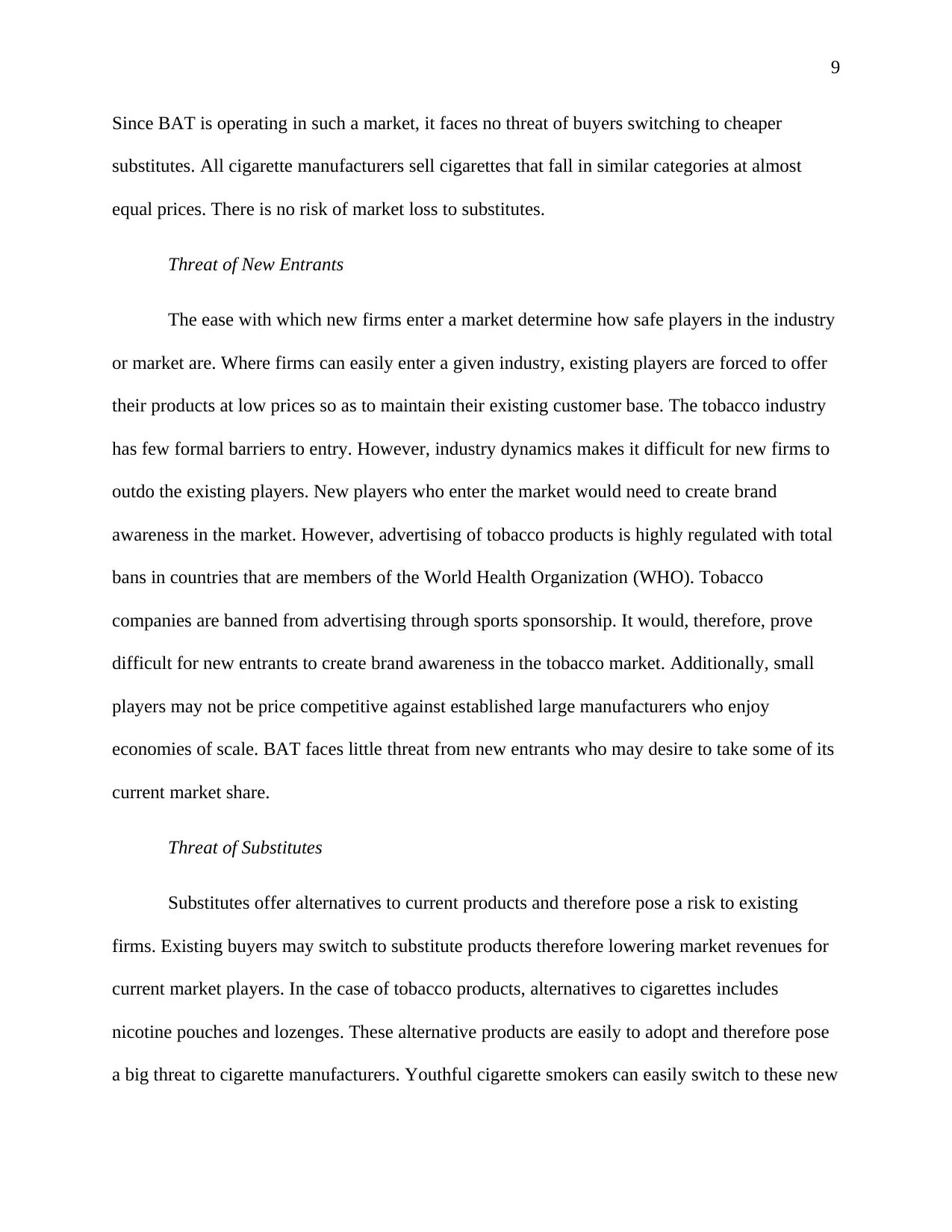
9
Since BAT is operating in such a market, it faces no threat of buyers switching to cheaper
substitutes. All cigarette manufacturers sell cigarettes that fall in similar categories at almost
equal prices. There is no risk of market loss to substitutes.
Threat of New Entrants
The ease with which new firms enter a market determine how safe players in the industry
or market are. Where firms can easily enter a given industry, existing players are forced to offer
their products at low prices so as to maintain their existing customer base. The tobacco industry
has few formal barriers to entry. However, industry dynamics makes it difficult for new firms to
outdo the existing players. New players who enter the market would need to create brand
awareness in the market. However, advertising of tobacco products is highly regulated with total
bans in countries that are members of the World Health Organization (WHO). Tobacco
companies are banned from advertising through sports sponsorship. It would, therefore, prove
difficult for new entrants to create brand awareness in the tobacco market. Additionally, small
players may not be price competitive against established large manufacturers who enjoy
economies of scale. BAT faces little threat from new entrants who may desire to take some of its
current market share.
Threat of Substitutes
Substitutes offer alternatives to current products and therefore pose a risk to existing
firms. Existing buyers may switch to substitute products therefore lowering market revenues for
current market players. In the case of tobacco products, alternatives to cigarettes includes
nicotine pouches and lozenges. These alternative products are easily to adopt and therefore pose
a big threat to cigarette manufacturers. Youthful cigarette smokers can easily switch to these new
Since BAT is operating in such a market, it faces no threat of buyers switching to cheaper
substitutes. All cigarette manufacturers sell cigarettes that fall in similar categories at almost
equal prices. There is no risk of market loss to substitutes.
Threat of New Entrants
The ease with which new firms enter a market determine how safe players in the industry
or market are. Where firms can easily enter a given industry, existing players are forced to offer
their products at low prices so as to maintain their existing customer base. The tobacco industry
has few formal barriers to entry. However, industry dynamics makes it difficult for new firms to
outdo the existing players. New players who enter the market would need to create brand
awareness in the market. However, advertising of tobacco products is highly regulated with total
bans in countries that are members of the World Health Organization (WHO). Tobacco
companies are banned from advertising through sports sponsorship. It would, therefore, prove
difficult for new entrants to create brand awareness in the tobacco market. Additionally, small
players may not be price competitive against established large manufacturers who enjoy
economies of scale. BAT faces little threat from new entrants who may desire to take some of its
current market share.
Threat of Substitutes
Substitutes offer alternatives to current products and therefore pose a risk to existing
firms. Existing buyers may switch to substitute products therefore lowering market revenues for
current market players. In the case of tobacco products, alternatives to cigarettes includes
nicotine pouches and lozenges. These alternative products are easily to adopt and therefore pose
a big threat to cigarette manufacturers. Youthful cigarette smokers can easily switch to these new
⊘ This is a preview!⊘
Do you want full access?
Subscribe today to unlock all pages.

Trusted by 1+ million students worldwide
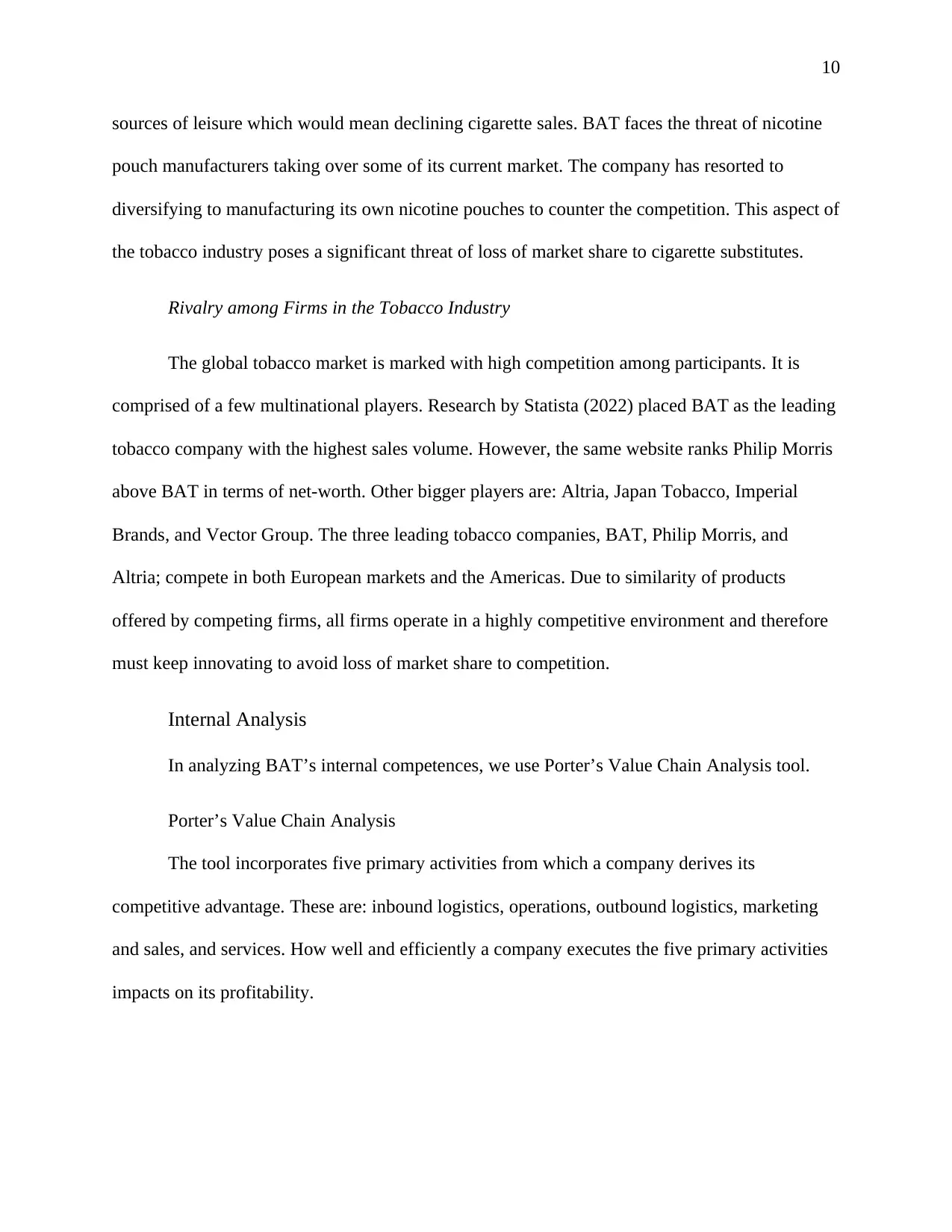
10
sources of leisure which would mean declining cigarette sales. BAT faces the threat of nicotine
pouch manufacturers taking over some of its current market. The company has resorted to
diversifying to manufacturing its own nicotine pouches to counter the competition. This aspect of
the tobacco industry poses a significant threat of loss of market share to cigarette substitutes.
Rivalry among Firms in the Tobacco Industry
The global tobacco market is marked with high competition among participants. It is
comprised of a few multinational players. Research by Statista (2022) placed BAT as the leading
tobacco company with the highest sales volume. However, the same website ranks Philip Morris
above BAT in terms of net-worth. Other bigger players are: Altria, Japan Tobacco, Imperial
Brands, and Vector Group. The three leading tobacco companies, BAT, Philip Morris, and
Altria; compete in both European markets and the Americas. Due to similarity of products
offered by competing firms, all firms operate in a highly competitive environment and therefore
must keep innovating to avoid loss of market share to competition.
Internal Analysis
In analyzing BAT’s internal competences, we use Porter’s Value Chain Analysis tool.
Porter’s Value Chain Analysis
The tool incorporates five primary activities from which a company derives its
competitive advantage. These are: inbound logistics, operations, outbound logistics, marketing
and sales, and services. How well and efficiently a company executes the five primary activities
impacts on its profitability.
sources of leisure which would mean declining cigarette sales. BAT faces the threat of nicotine
pouch manufacturers taking over some of its current market. The company has resorted to
diversifying to manufacturing its own nicotine pouches to counter the competition. This aspect of
the tobacco industry poses a significant threat of loss of market share to cigarette substitutes.
Rivalry among Firms in the Tobacco Industry
The global tobacco market is marked with high competition among participants. It is
comprised of a few multinational players. Research by Statista (2022) placed BAT as the leading
tobacco company with the highest sales volume. However, the same website ranks Philip Morris
above BAT in terms of net-worth. Other bigger players are: Altria, Japan Tobacco, Imperial
Brands, and Vector Group. The three leading tobacco companies, BAT, Philip Morris, and
Altria; compete in both European markets and the Americas. Due to similarity of products
offered by competing firms, all firms operate in a highly competitive environment and therefore
must keep innovating to avoid loss of market share to competition.
Internal Analysis
In analyzing BAT’s internal competences, we use Porter’s Value Chain Analysis tool.
Porter’s Value Chain Analysis
The tool incorporates five primary activities from which a company derives its
competitive advantage. These are: inbound logistics, operations, outbound logistics, marketing
and sales, and services. How well and efficiently a company executes the five primary activities
impacts on its profitability.
Paraphrase This Document
Need a fresh take? Get an instant paraphrase of this document with our AI Paraphraser
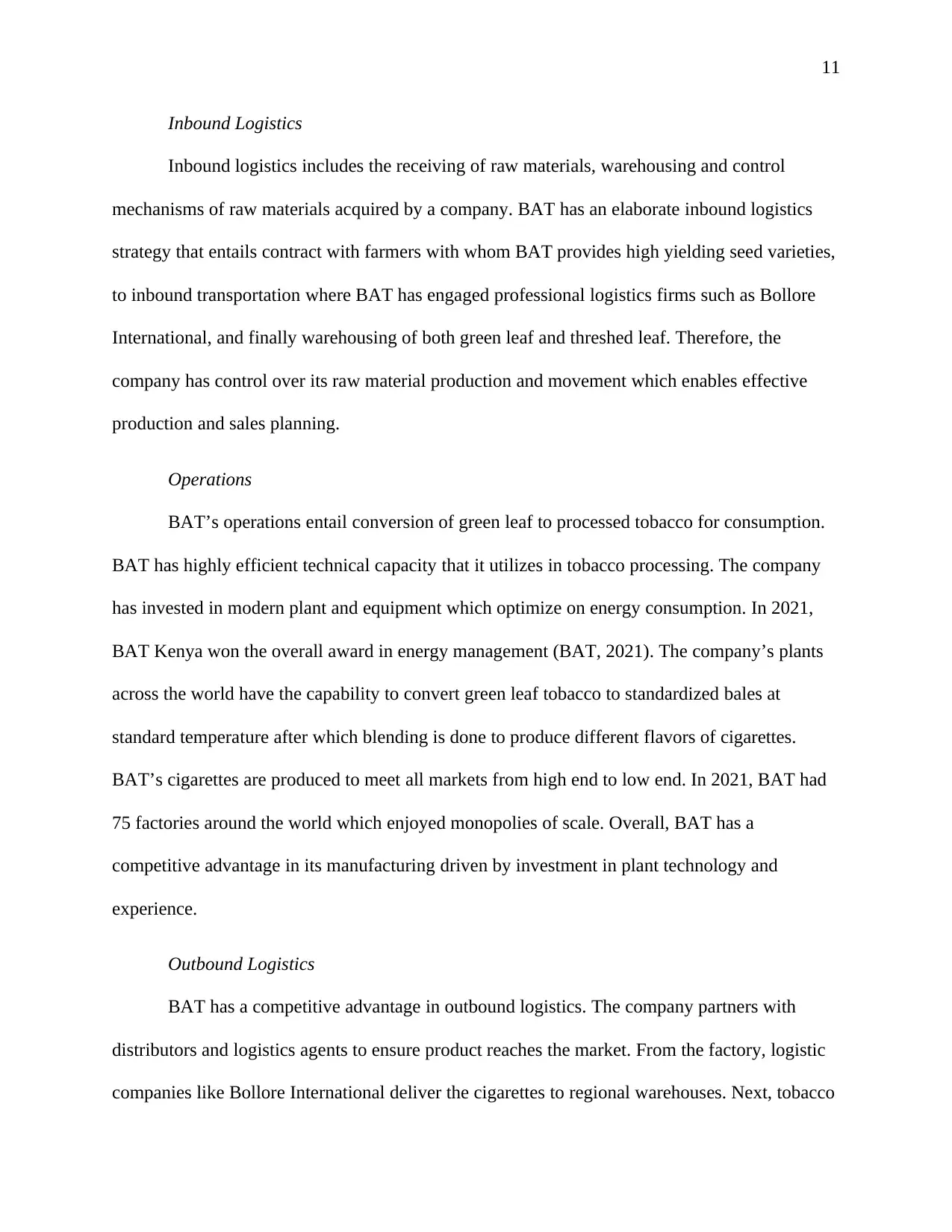
11
Inbound Logistics
Inbound logistics includes the receiving of raw materials, warehousing and control
mechanisms of raw materials acquired by a company. BAT has an elaborate inbound logistics
strategy that entails contract with farmers with whom BAT provides high yielding seed varieties,
to inbound transportation where BAT has engaged professional logistics firms such as Bollore
International, and finally warehousing of both green leaf and threshed leaf. Therefore, the
company has control over its raw material production and movement which enables effective
production and sales planning.
Operations
BAT’s operations entail conversion of green leaf to processed tobacco for consumption.
BAT has highly efficient technical capacity that it utilizes in tobacco processing. The company
has invested in modern plant and equipment which optimize on energy consumption. In 2021,
BAT Kenya won the overall award in energy management (BAT, 2021). The company’s plants
across the world have the capability to convert green leaf tobacco to standardized bales at
standard temperature after which blending is done to produce different flavors of cigarettes.
BAT’s cigarettes are produced to meet all markets from high end to low end. In 2021, BAT had
75 factories around the world which enjoyed monopolies of scale. Overall, BAT has a
competitive advantage in its manufacturing driven by investment in plant technology and
experience.
Outbound Logistics
BAT has a competitive advantage in outbound logistics. The company partners with
distributors and logistics agents to ensure product reaches the market. From the factory, logistic
companies like Bollore International deliver the cigarettes to regional warehouses. Next, tobacco
Inbound Logistics
Inbound logistics includes the receiving of raw materials, warehousing and control
mechanisms of raw materials acquired by a company. BAT has an elaborate inbound logistics
strategy that entails contract with farmers with whom BAT provides high yielding seed varieties,
to inbound transportation where BAT has engaged professional logistics firms such as Bollore
International, and finally warehousing of both green leaf and threshed leaf. Therefore, the
company has control over its raw material production and movement which enables effective
production and sales planning.
Operations
BAT’s operations entail conversion of green leaf to processed tobacco for consumption.
BAT has highly efficient technical capacity that it utilizes in tobacco processing. The company
has invested in modern plant and equipment which optimize on energy consumption. In 2021,
BAT Kenya won the overall award in energy management (BAT, 2021). The company’s plants
across the world have the capability to convert green leaf tobacco to standardized bales at
standard temperature after which blending is done to produce different flavors of cigarettes.
BAT’s cigarettes are produced to meet all markets from high end to low end. In 2021, BAT had
75 factories around the world which enjoyed monopolies of scale. Overall, BAT has a
competitive advantage in its manufacturing driven by investment in plant technology and
experience.
Outbound Logistics
BAT has a competitive advantage in outbound logistics. The company partners with
distributors and logistics agents to ensure product reaches the market. From the factory, logistic
companies like Bollore International deliver the cigarettes to regional warehouses. Next, tobacco
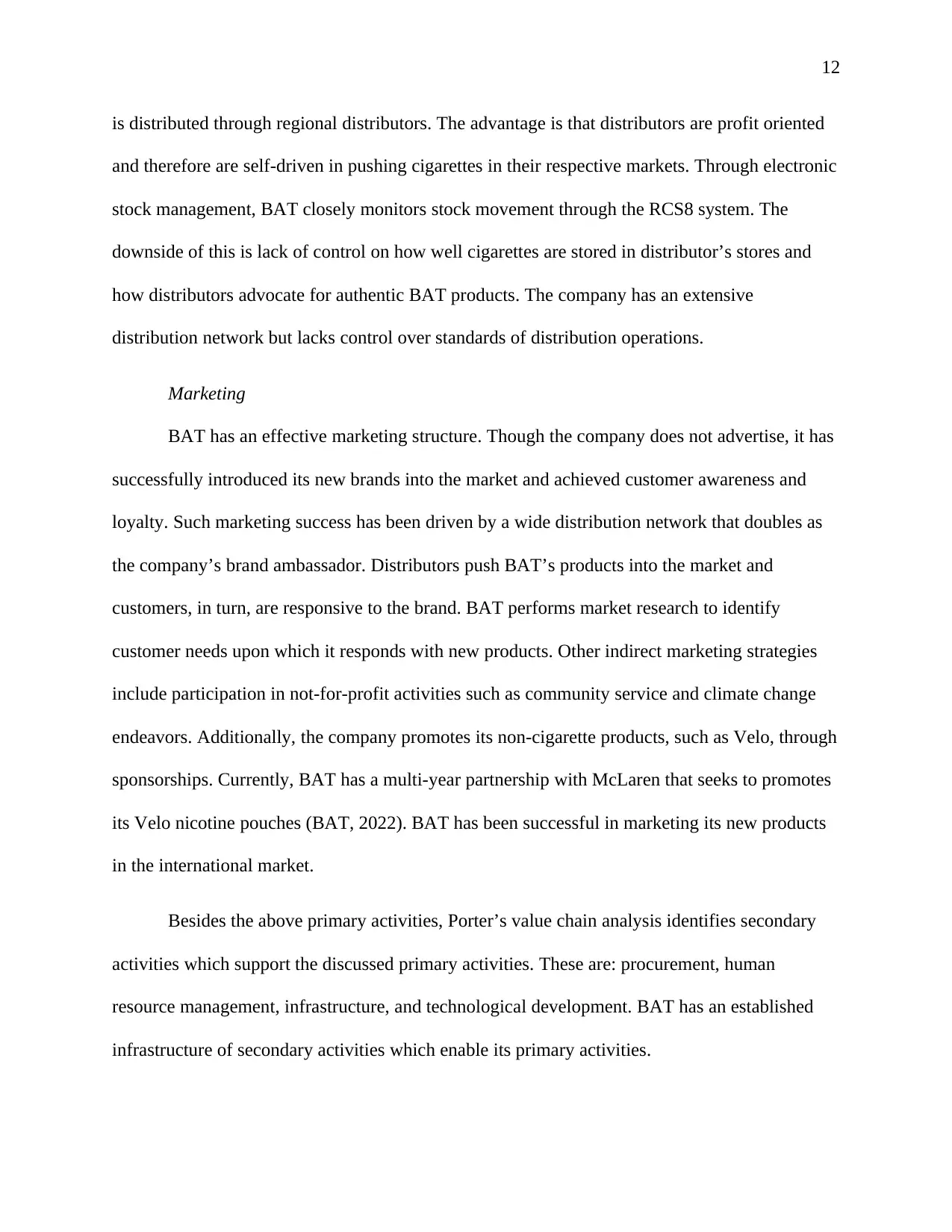
12
is distributed through regional distributors. The advantage is that distributors are profit oriented
and therefore are self-driven in pushing cigarettes in their respective markets. Through electronic
stock management, BAT closely monitors stock movement through the RCS8 system. The
downside of this is lack of control on how well cigarettes are stored in distributor’s stores and
how distributors advocate for authentic BAT products. The company has an extensive
distribution network but lacks control over standards of distribution operations.
Marketing
BAT has an effective marketing structure. Though the company does not advertise, it has
successfully introduced its new brands into the market and achieved customer awareness and
loyalty. Such marketing success has been driven by a wide distribution network that doubles as
the company’s brand ambassador. Distributors push BAT’s products into the market and
customers, in turn, are responsive to the brand. BAT performs market research to identify
customer needs upon which it responds with new products. Other indirect marketing strategies
include participation in not-for-profit activities such as community service and climate change
endeavors. Additionally, the company promotes its non-cigarette products, such as Velo, through
sponsorships. Currently, BAT has a multi-year partnership with McLaren that seeks to promotes
its Velo nicotine pouches (BAT, 2022). BAT has been successful in marketing its new products
in the international market.
Besides the above primary activities, Porter’s value chain analysis identifies secondary
activities which support the discussed primary activities. These are: procurement, human
resource management, infrastructure, and technological development. BAT has an established
infrastructure of secondary activities which enable its primary activities.
is distributed through regional distributors. The advantage is that distributors are profit oriented
and therefore are self-driven in pushing cigarettes in their respective markets. Through electronic
stock management, BAT closely monitors stock movement through the RCS8 system. The
downside of this is lack of control on how well cigarettes are stored in distributor’s stores and
how distributors advocate for authentic BAT products. The company has an extensive
distribution network but lacks control over standards of distribution operations.
Marketing
BAT has an effective marketing structure. Though the company does not advertise, it has
successfully introduced its new brands into the market and achieved customer awareness and
loyalty. Such marketing success has been driven by a wide distribution network that doubles as
the company’s brand ambassador. Distributors push BAT’s products into the market and
customers, in turn, are responsive to the brand. BAT performs market research to identify
customer needs upon which it responds with new products. Other indirect marketing strategies
include participation in not-for-profit activities such as community service and climate change
endeavors. Additionally, the company promotes its non-cigarette products, such as Velo, through
sponsorships. Currently, BAT has a multi-year partnership with McLaren that seeks to promotes
its Velo nicotine pouches (BAT, 2022). BAT has been successful in marketing its new products
in the international market.
Besides the above primary activities, Porter’s value chain analysis identifies secondary
activities which support the discussed primary activities. These are: procurement, human
resource management, infrastructure, and technological development. BAT has an established
infrastructure of secondary activities which enable its primary activities.
⊘ This is a preview!⊘
Do you want full access?
Subscribe today to unlock all pages.

Trusted by 1+ million students worldwide
1 out of 26
Related Documents
Your All-in-One AI-Powered Toolkit for Academic Success.
+13062052269
info@desklib.com
Available 24*7 on WhatsApp / Email
![[object Object]](/_next/static/media/star-bottom.7253800d.svg)
Unlock your academic potential
Copyright © 2020–2025 A2Z Services. All Rights Reserved. Developed and managed by ZUCOL.





